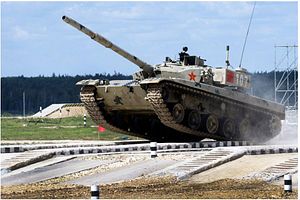The Chinese People’s Liberation Army (PLA) currently fields the world’s largest active service main battle tank (MBT) force, according to an analysis published in the newly released Military Balance 2018 report, produced by the International Institute of Strategic Studies (IISS).
As of 2017, the PLA’s operational tank fleet is composed of roughly 3,390 third-generation, 400 second-generation, and 2,850 first-generation MBTs. In comparison, in 1997 the force consisted of 6,200 first-generation and 1,600 second-generation MBTs.
The PLA still operates 2,850 ZTZ-59, ZTZ-59-II, ZTZ-59D, license-built variants of the obsolete Soviet T-54 MBT, with the latest version of the tank undergoing upgrades in the 1980s. “The original ZTZ-59 remains in service with a significant proportion of the PLA, despite being effectively obsolete, even in its upgraded forms,” IISS notes.
The 500 second-generation MBTs currently in service are the ZTZ-79 (some analysts consider the ZTZ-79 a first-generation MBT) and ZTZ-88/ZTZ-88B, with the former in production until the end of the 1980s and the latter throughout the 1990s. Both second-generation MBTs were indigenously designed and developed combining a Soviet-style chassis and turret with Western technology including local copies of the U.K.’s Royal Ordnance 7 rifled tank gun.
However, “early indigenous Chinese tank designs, such as the ZTZ-79 and ZTZ-88, had limited production runs and are now only in the inventory of a small number of units in northern and western China,” IISS states. (ZTZ-79 MBTs were largely exported.)
Ongoing military reforms, especially the new emphasis on smaller and more agile units will likely impact the long-term future of second-generation MBTs currently in service. “The reorganization of PLA maneuver units into combined-arms brigades in 2017 may result in these second-generation designs being removed from service altogether as the overall size of the PLA’s tank fleet shrinks again,” according to IISS. (The size of the second-generation MBT force fell from 800 to 500 over the last five years.)
The bulk of the PLAs MBT force in 2018 and in the years ahead consists of ZTZ-96/ZTZ-96A and more advanced ZTZ-99/ZTZ-99A third-generation tanks. “The latest ZTZ-99A appears to have been produced in relatively small numbers, and issued to strategic-reserve units near Beijing, possibly because of its relatively high cost,” IISS explains. “The majority of China’s third-generation tanks are still versions of the late 1990s ZTZ-96 design.”
I came to a similar conclusion in 2016: “Chinese military analysts believe that the ZTZ-96B is more likely to become the new workhorse of the PLA’s armored force than more advanced Type 99 (ZTZ-99) and Type 99-A third-generation MBTs (…) citing the tanks’ high price tag and China’s still limited production capability.
As I reported previously, the PLA operates around 2,500 Type-96A MBTs with an unknown number upgraded to the Type-96B variant, which purportedly features improved communication systems, possibly a new engine, as well as improved targeting capabilities.
According to a Diplomat estimate, the PLA currently has a little over 600 ZTZ-99 and ZTZ-99A in its active duty inventory, while the remaining third-generation tank force is composed of ZTZ-96/ZTZ-96A/B variants.
The PLA has also developed and designed a new light tank, designated ZTQ-15, for service in high altitude regions. It is unclear whether the tank is already in serial production. In June 2017, the ZTQ-15 reportedly underwent test trials on the Tibetan Plateau in western China.
































